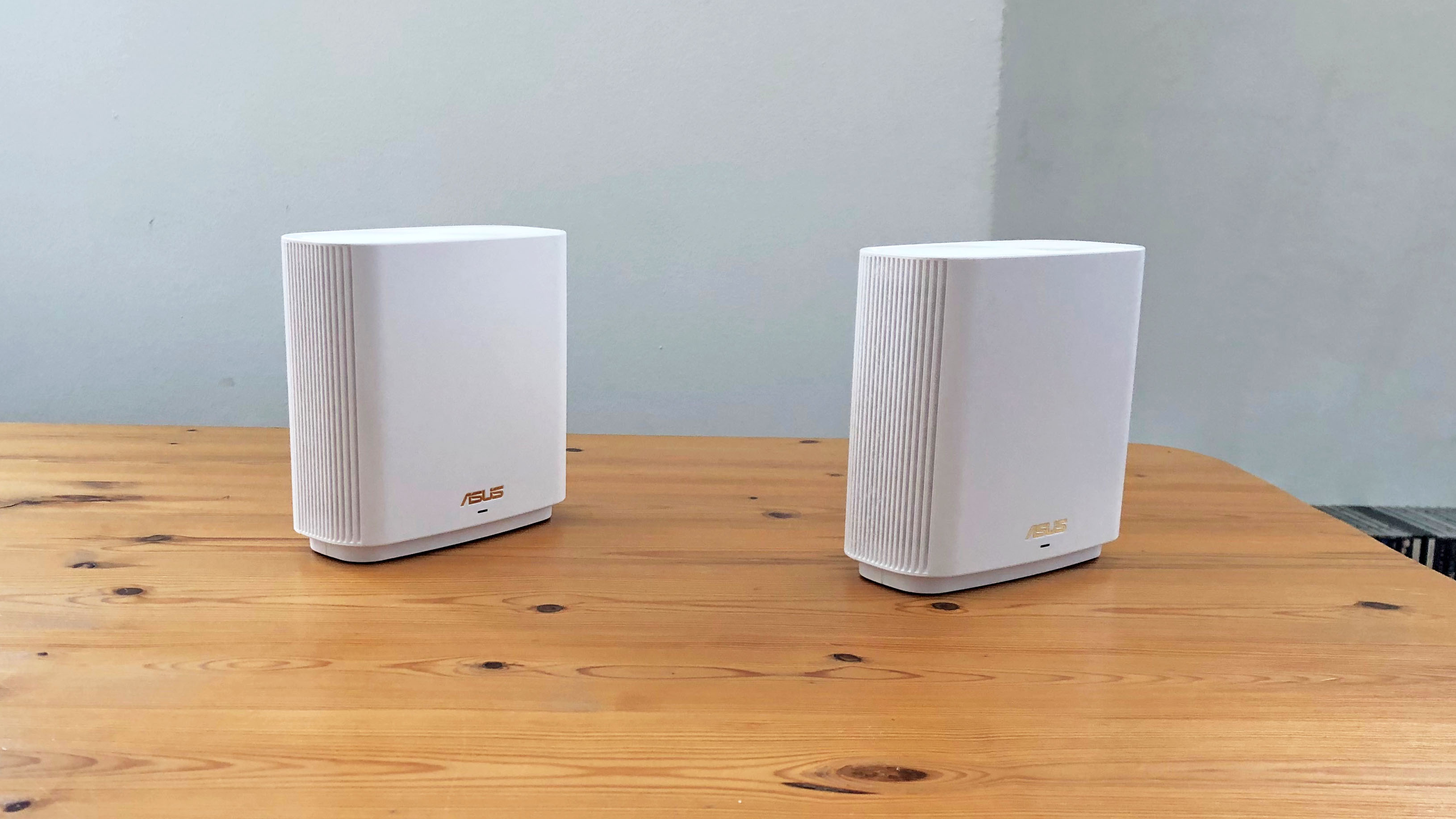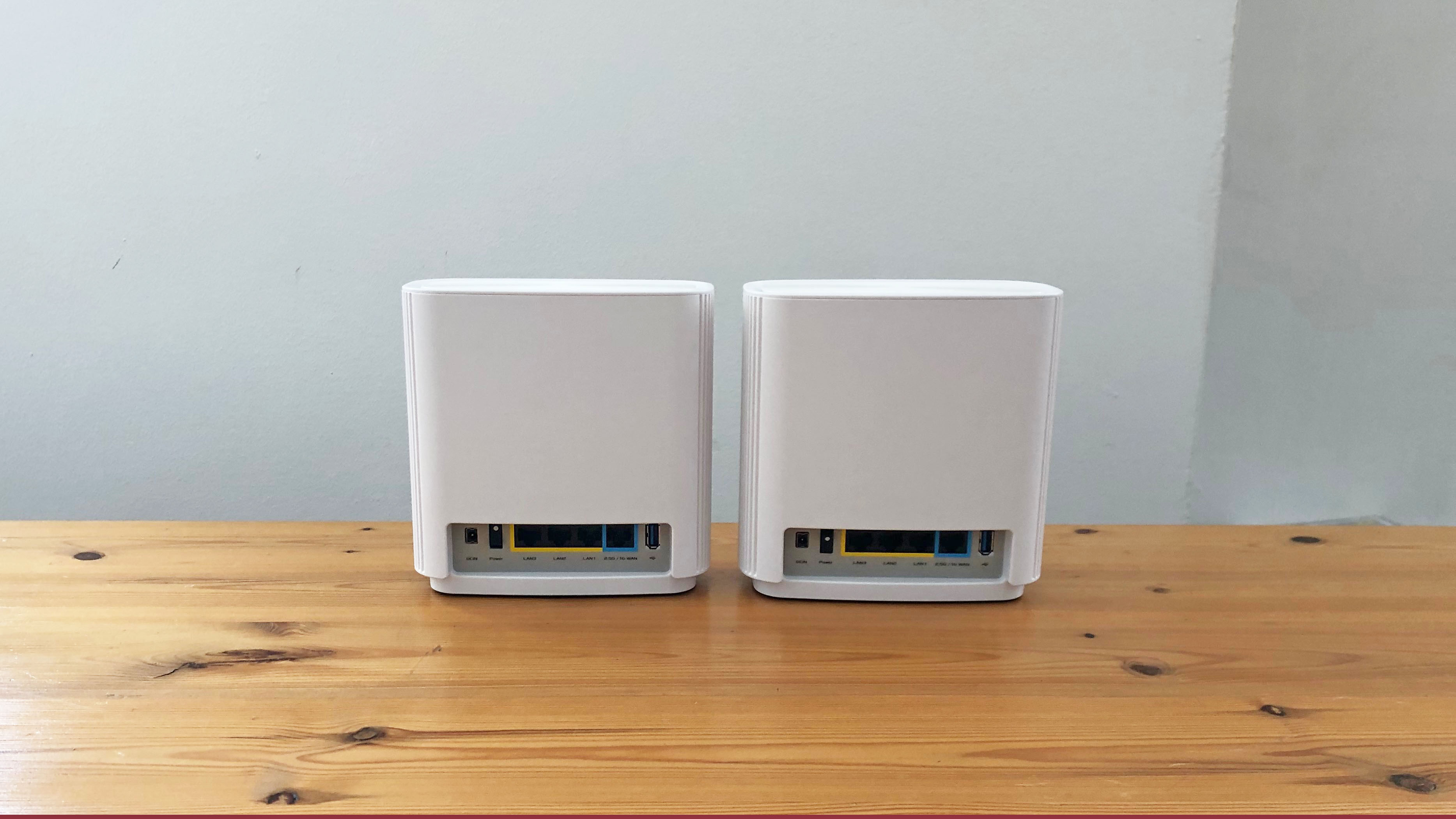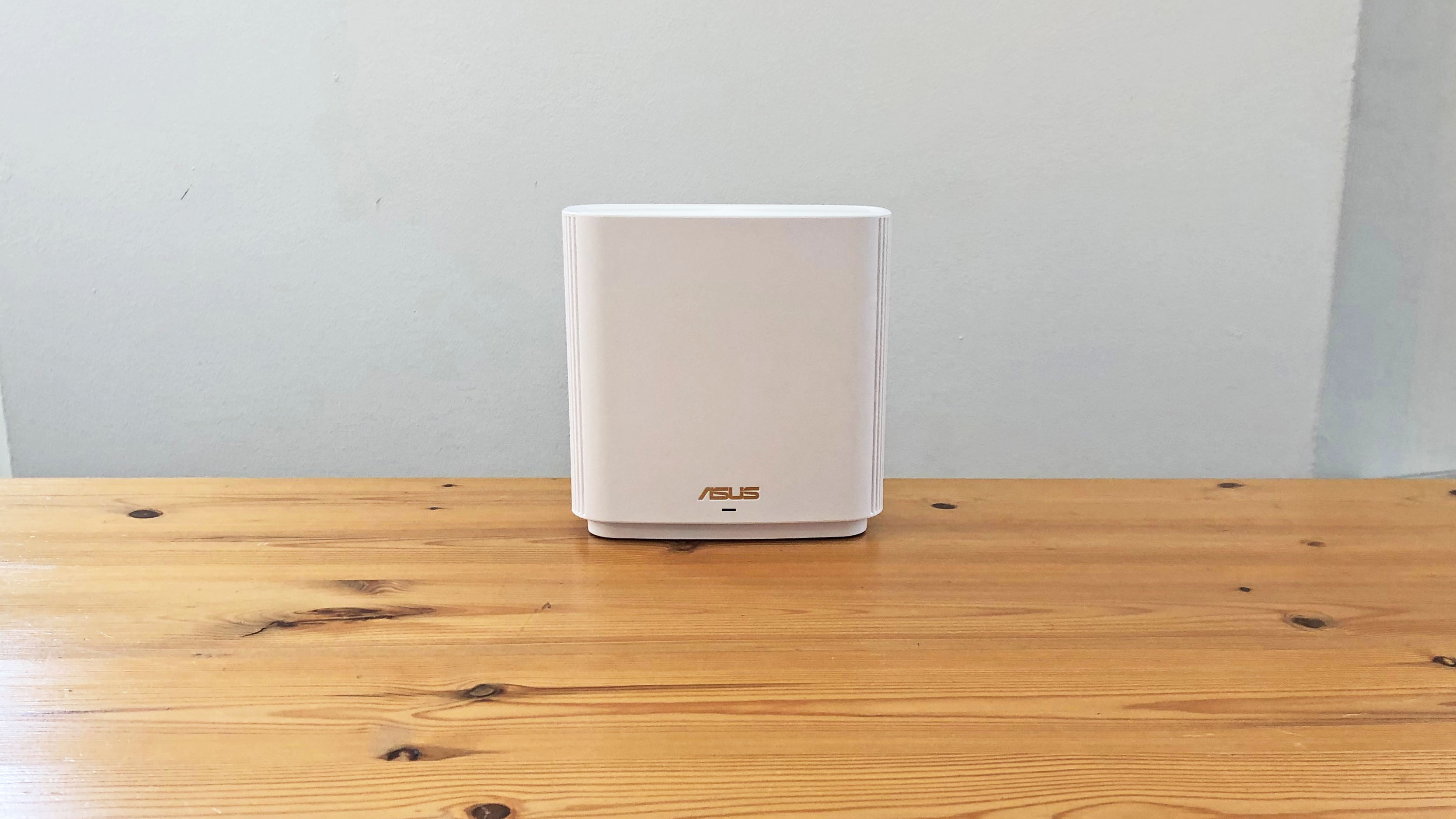TechRadar Verdict
It’s expensive, and not everyone will need the sheer speed of Wi-Fi 6, but the new ZenWiFi AX mesh networking system provides top-of-the-range performance for streaming video, gaming and other online activities. The Asus app also impresses with a good set of advanced controls, security features, and content filtering for parents of young children.
Pros
- +
Top-of-the-range Wi-Fi speeds
- +
Good parental controls
- +
Versatile app and security features
Cons
- -
Expensive
- -
Fiddly set-up process
- -
Currently no three-router option for larger homes
Why you can trust TechRadar
Two-minute review
The Asus ZenWifi AX (XT8) might not be for everyone. But, for those that can stomach the cost and want a mesh router with top-of-the-line performance, an equally impressive app, and some solid security features, this Asus router should top the list.
In fact, it tops our best router guide for just those very reasons. It’s also among the best mesh router systems and can go head-to-head with best Wi-Fi 6 routers out there. Considering all the routers we’ve tested over the years, that’s no small feat.
While you can’t buy the ZenWifi AX (XT8) directly from Asus in Australia, you can in other territories. Moreover, it’s very easy to find stock online. UK users looking to upgrade their router to something supporting Wi-Fi 6 can purchase a single unit for £219.99 to cover an area of up to 2475sq.ft. Strangely, that single router option seems to only be available in the UK.
We reviewed the two-piece mesh system here which can cover a good 4400 square feet of space and will set you back a relatively large sum of £399.99/US $449.99/AU $899.00. You can get it in either black or white, but make sure not to confuse it with the cheaper but almost identical looking Asus ZenWifi AC (CT8), as that uses the older and slower 802.11ac version of Wi-Fi.
Design and features

Wireless Connectivity: Wi-Fi 6 (IEEE 802.11ax), tri-band 2.4GHz and 2x 5.0GHz
Processor: Quad-core Broadcom BCM6755 @1.5GHz
Memory: 512MB
Storage: 256MB Flash
Beamforming: Implicit and Explicit for 2.4GHz and 5GHz
Ports: 2.5Gb WAN, 3x Gigabit Ethernet; 1x USB 3.1
Dimensions (HxWxD): 161 x 160x 75mm
It’s expensive, even by the standards of new Wi-Fi 6 routers, but the Asus ZenWiFi AX earns its keep with an impressive combination of features and performance.
The two routers support tri-band Wi-Fi 6 (802.11ax) on the 2.4GHz and two 5.0GHz bands, with a total speed of 6600Mbps (6.6Gbps). That’s far beyond the speed of most current routers that use 802.11ac wi-fi, and even faster than many new Wi-Fi 6 routers as well.
However, Wi-Fi 6 is still compatible with millions of devices that use 802.11ac Wi-Fi, so you shouldn’t have any problem using it with your existing computers and mobile devices.
Sign up for breaking news, reviews, opinion, top tech deals, and more.
There are few home broadband services that come anywhere near the speeds supported by Wi-Fi 6, so Asus sets aside one of the 5.0GHz bands to be used as a ‘backhaul’ that provides a high-speed link between the two mesh routers, while still leaving the remaining 2.4GHz and 5.0GHz bands to transmit data to your computers and mobile devices.
To make the most of the router’s performance, each router also has a 2.5 Gigabit Ethernet port for high-speed Internet connections, along with three additional Gigabit Ethernet ports for devices that need a wired network connection, and a USB 3.1 port for sharing a USB storage device on your network.
Set-up and performance

Ookla Speed Test - 2.4GHz
Within 5ft, no obstructions: 60.0/6.0Mbps (download/upload)
Within 30ft, three partition walls: 60.0/6.0Mbps (download/upload)
Ookla Speed Test - 5.0GHz
Within 5ft, no obstructions: 60.0/6.0Mbps (download/upload)
Within 30ft, three partition walls: 60.0/6.0Mbps (download/upload)
20GB Steam download - 2.4GHz
Within 5ft, no obstructions: 7.4MB/s
Within 30ft, three partition walls: 7.3MB/s
20GB Steam 20GB download - 5.0GHz
Within 5ft, no obstructions: 7.4MB/s
Within 30ft, three partition walls: 7.2MB/s
The Asus Router app and set-up procedure aren’t quite as straightforward as we’ve seen from other mesh systems, but once you’ve got everything running the app does provide an impressive range of features.
Most mesh systems start by using an Ethernet cable to connect the first mesh router to your existing broadband router, and you then place the other mesh routers further away in other rooms around your home. The Asus app doesn’t tell you anything at this point at all, so you have to read ye olde printed manual to find out how to get started. And, somewhat unusually, both routers initially have to be plugged in and set up together in the same room - preferably sitting within three metres of each other.
The Asus app then uses a Bluetooth connection on your iOS or Android mobile device to set up your new mesh network. And, unlike many routers and mesh systems, we were pleased to see that it starts off straight away by asking if you want to create a single network that combines the 2.4GHz and 5.0GHz bands, or create two separate networks with different names and passwords. Once that’s done you can unplug the second ZenWifi router and move it into another room to complete your new network.
Again, though, the app doesn’t help you here, leaving you to flick through the printed manual to find that information. It also has a tendency to throw jargon around, such as ‘dynamic DNS’, without explaining what it means, so Asus could do a bit more to clarify the set-up process for people who aren’t too familiar with mesh technology.
Thankfully, though, the Asus app is more straightforward once you’ve got your new mesh networking up and running, and includes a good set of parental controls and other features. You can create profiles for family members under the age of 18, which are linked to the devices they use. These profiles allow you to create a schedule for Internet access, as well as using content filters to block unsuitable adult material, gambling or messaging apps for younger children.
There’s also a simple option for ‘QoS’ - quality of service - that allows you to prioritise bandwidth for specific services, such as streaming video or gaming, and even a bandwidth ‘limiter’ that can restrict the bandwidth used by individual devices.
The app also includes Asus’ AiProtection features, which keep an eye out for malicious websites, malware, and other outside attempts to hack into your home network. Many routers and mesh systems charge additional subscription fees for security features and parental controls such as these, so it’s good to see Asus providing these features without any additional charge.
We weren’t disappointed by the performance of the ZenWifi AX either. It’s not cheap, of course, but it pushed our 50Mbps Internet connection all the way - even squeezing it up to 60Mbps at one point (which sometimes happens when the weather is good for some reason). And, crucially, it was able to maintain that speed even in our back office, which often struggles to get a good wi-fi signal. Downloads from Steam hit 7.4MB/s for devices in the same room as the first ZenWifi, and barely flickered as we moved into the back office, with download speeds holding steady at 7.3MB/s even on the slower 2.4GHz band.

Buy it if…
You really need fast Wi-Fi
With tri-band Wi-Fi 6, the ZenWiFi AX is able to create a high-speed ‘backhaul’ that connects the two mesh routers, while still providing 2.4GHz and 5.0Ghz bands for high-speed video streaming, music, and gaming.
You have weak Wi-Fi in some rooms
Mesh networking systems aren’t just about speed - they’re also designed to eliminate ‘deadspots’ in rooms or other locations that normally struggle to get a good wi-fi signal. The ZenWiFi AX is expensive, but it really impressed us with its ability to maintain fast wi-fi even in the most remote corners of our office.
You’ve got kids
Some routers and mesh systems provide only basic features in their apps, and then try to charge you an extra monthly subscription for additional parental controls and other advanced features. However, the Asus Router app has good parental controls and security features that don’t require a subscription fee.
Don’t buy it if…
You’re on a budget
The ZenWiFi AX is a top-of-the-range Wi-Fi mesh system that runs far faster than most home broadband services. There are plenty of less expensive mesh systems that can still handle streaming video and gaming with no trouble at all.
You live in a palace
Most mesh systems are available with either two or three routers in order to accommodate homes of different sizes. Somewhat oddly, the expensive ZenWiFi AX is only available with two routers that cover up to 4400 sq.ft, with no three-router option for even larger homes.
You don’t like jargon
The Asus Router app is full of useful features and parental controls. However, its set-up process is a little long-winded and it tends to throw quite a bit of jargon around, so it could be a bit daunting for newcomers to mesh technology.
Looking to save money on an Asus device? Check out our Asus discounts for big savings on top tech.
Cliff Joseph is a former Editor of MacUser magazine, and a freelance technology writer with 30 year’s experience in the industry (and old enough to remember when Apple was close to going bust…).
His first job involved using Macs for magazine sub-editing and typesetting, which led to the realisation that these computer-thingies might actually turn out to be useful after all. After a few years specialising in the Mac side of the market, he went freelance and embraced the wide world of digital technology, including Windows PCs, digital audio and hi-fi, and networking. Somewhere along the line he also developed a bit of a gaming habit and has stubbornly waved the flag for Mac gaming for far too many years.
